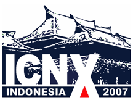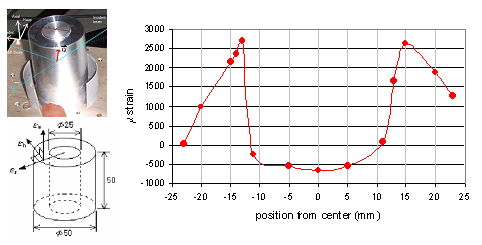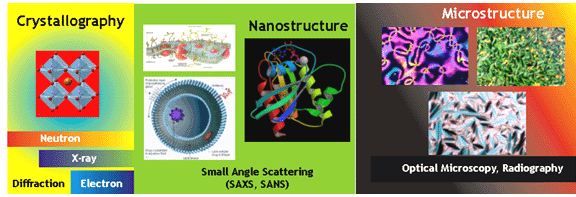

NEUTRON SPECTROMETRY DIVISION
Neutron Scattering Laboratory
This site presents the facilities available in the Neutron Scattering Laboratory (NSL) Serpong which have been in operation for the last thirteen years after the inauguration by the President of the Republic of Indonesia on August 20, 1992 . During that thirteen-year time most of the activities were inward looking including calibrations and characterizations of the instruments. In the last five years the control systems of several instruments have been built with local components by our own instrument scientists to replace the old ones. From now on we are looking forward to conduct more experiments with neutron scatterers from all over the world. After mentioning the reactor, this site describes the neutron scattering facilities together with some results that have been obtained. Contact person for each instrument is also mentioned.
I am looking forward to welcoming you for running some experiments with our neutron scattering facilities.
Abarrul Ikram
Head of Neutron Scattering Laboratory

Neutron scattering activity in Indonesia has been started since the first research reactor TRIGA Mark II in Indonesia located in Bandung , West Java is commissioned in early 60's. Marsongkohadi, a lecturer at Physics Department, Institut Teknologi Bandung, ITB has been recognized as a founder of neutron scattering research in Indonesia . He and his group in Bandung Nuclear Centre, including Djajusman designed and then built a very simple neutron diffractometer for crystal structure research using neutron diffractometer. Since the largest research reactor in Indonesia is commissioned in 1987, the possibility to build a neutron scattering laboratory with more comprehensive instruments becomes widely open. In 1992, BATAN commissioned some instruments, in the neutron scattering laboratory (NSL) Serpong, utilizing neutrons produced by the Multi-Purpose Reactor (RSG) G. A. Siwabessy in Serpong.
The NSL Serpong at the 30 MW research reactor is sited at Serpong Nuclear Technique Research centre, 30km southwest of Jakarta . The reactor and its facilities are owned and operated by the National Nuclear Energy Agency - Indonesia (BATAN). The laboratory is facilitated with four-circle diffractometer/texture diffractometer (FCD/TD), triple axis spectrometer (TAS), neutron radiography facility (NRF), small angle neutron scattering (SANS) spectrometer, high-resolution small angle neutron scattering (HRSANS) spectrometer and high-resolution powder diffractometer (HRPD). The first three instruments together with a residual stress measurement (RSM) diffractometer were installed in the reactor experimental hall (XHR) while the last three are located in the neutron guide hall (NGH). Those two halls are connected by a tunnel accommodating two neutron guides transferring neutrons from the reactor to the instruments in the neutron guide hall.
The instruments that deal with the classical domain of neutron scattering, i.e. powder diffractometer and triple axis spectrometer, are more or less standard, and only brief

Layout of Neutron Scattering Facility
Neutron Scattering Facilities1. Residual Stress Measurement (RSM) Diffractometer
The powder diffractometer was the first instrument installed (1987) and situated in the reactor experimental hall (XHR). It is a standard two-axis type diffractometer with a Si (311) monochromator system that is slightly bent horizontally and focused vertically to enhance the neutron flux at the sample position. Take-off angle of the monochromator can be varied from 0 to 90 degrees allowing some different neutron wavelength to be used. Mylar films coated with gadolinium are used for collimators with angular divergences of 40’ before the monochromator system and 20’ or 40’ after the sample. In collaboration with the Japan Atomic Energy Research Institute (JAERI), In 1995 the powder diffractometer was modified to accommodate residual stress measurements and has been used for the measurements since. As seen in figure below the residual stress measurement diffractometer, the triple axis spectrometer and the neutron radiography facility are installed at the beam ports S6 (tangential), S4 (radial), and S2 (tangential), respectively in the experimental hall of the reactor (XHR). While, two neutron guides are installed starting from radial beam port S5 and going through the reactor confinement and a 35m tunnel into the external neutron guide hall (NGH).
Modifications were made by installing a goniometer having three orthogonal translations as well as a turn table to rotate samples around the incident beam with positioning accuracy of 0.1 mm. All sample movements and data collection are controlled by an IBM PC computer. The size of both incident and scattered beams is defined by apertures having various sizes ranging from 2x2mm2 to 10 mm (diameter). The volume sampled by the diffractometer is then defined by the intersection of the incident and scattered beams in the scattering plane. Residual stress in a standard specimen of a shrink-fit ring plug has been measured to test the performance of the machine. The result shows that this machine has a comparable capability to RESA in JRR-3M at JAERI.

Latest development includes detector movement mechanism which allows the detector to be moved closer to the sample table and increase the neutron intensity significantly. The full circle goniometer has also installed on the sample table. Therefore, characterization of textured samples could be done before residual stress measurement.
Measurement result of Shrink&Fit sample in hoop direction is given on the graph in below. Detail of sample and principal axis of measurement Shrink&Fit sample is described in the picture in below. The inner diameter of ring and plug are 25 mm and 25.1 mm, respectively. The Plug dip into liquid Nitrogen and promptly insert to the Ring. Due to thermal expansion the plug locked in the ring.
This diffractometer has been used intensively for residual stress measurement of composite materials and alloys by Dr. M. Nishida, Kobe City College of Technology, Japan, S. Ohkido from Hitachi Research Laboratory, Japan as well as researchers from BATAN. A recent publication on internal stress measurement of fiber reinforced composite with in-situ temperature stress measurement system has been published in Materials Science Forum, Vol. 490 – 491, 2005, 239 – 244.
Contact Person:
Ir. M. Rifai Muslich
e-mail: rifai@batan.go.id2. Four-Circle Diffractometer/Texture Diffractometer (FCD/TD)
This diffractometer is installed at the NG2-1 beam port sited in the XHR. The dual purpose instrument was designed for single crystal structural studies and texture measurements, and was constructed robustly to allow heavy attachments. The allowable load on the sample table is 300 kg. A Cu (220) or PG (004) monochromator with a fixed take off angle of 460 is mounted inside the neutron guide casemate to obtain monochromatic beam having a wavelength of 0.997 Å or 1.311 Å for Cu (220) or PG (004) monochromator, respectively. The maximum beam size at the sample position is 40 x 40 mm2 and the detector is BF3 end window counter with 100 mm2 and 236 mm effective length. The centre of sample table is 1500 mm from the front-end of first collimator and 350 mm from the detector.
This instrument is operated automatically by an IBM compatible computer using Windows Millenium Operating System. Visual Basic v6 is used for control system and data acquisition. Ancillary equipments available are full and half circle Eulerian goniometers, a fiber specimen holder and a cryostat. The picture of the diffractometer is shown at the end of this section.
Using q-2q scan, neutron diffraction pattern of MgZn2(200) compound (commercially called A-7075) is obtained. From neutron diffraction pattern, a (200) plane was chosen for texture experiment. Reflection method is used for the experiment. Texture distribution at “hoop” direction on (200) plane was determined. Figure of a pole figure of MgZn2 (200) compound is shown below, while on left the table of texture distribution is presented.
Contact Person:
Drs. Trihardi P., MT
e-mail: thardi@batan.go.id
3. High-Resolution Powder Diffractometer (HRPD)
The High Resolution Powder Diffractometer (HRPD) is a versatile diffractometer to study the crystallographic and magnetic structure based on powder samples. As X-ray diffraction is insensitive to light atoms such as hydrogen and oxygen, neutron diffraction is indispensable for materials containing light atoms. Furthermore, neutron has inherent magnetic moment that enables probing the magnetic structure ranging from collinear-commensurate to incommensurate configurations.
This diffractometer is located at the neutron guide (NG2) about 71 meter away from the reactor core. The monochromator drum, designed for installation in the neutron guide, has three exits corresponding to three take off angles, 2qM = 41.5°, 89° and 130°. At present the instrument is set for 2qM = 89°.
A pyrolitic graphite as a focusing monochromator composed of five PG(004) single crystals provides a focus neutron beam having a wavelength of 2.352 Å. Although two PG(002) filters had been inserted in front of the sample, higher order peaks still appeared in the diffraction pattern. Later on, to overcome this problem, a hot pressed germanium single crystal replaced the pyrolitic graphite monochromator. The Ge(331) single crystal was pressed up to 70 kgcm-2 during heating at 850 °C to increase the mosaic spread. The intensity of the monochromatic beam with l = 1.822 Å increased.
Contact Person:
Dr. Andika Fajar
e-mail: andika@batan.go.id4. Small Angle Neutron Scattering (SANS) Spectrometer
This instrument is installed at the end of the 49-meter long neutron guide (NG1) and situated in the neutron guide hall (NGH) to benefit from low background environment. A slot type mechanical velocity selector having a minimum rotational speed of 700 rpm and maximum speed of 7000 rpm monochromatizes the incident beam. The selector’s tilt angle can be varied originally from -3.9° to +3.9°, but now it is fixed at 0°. By varying the rotational speed, neutron wavelengths of 0.2 – 0.5 nm and Q range of 0.05 < Q < 3 nm-1 can be obtained with l = 0.4 nm
The collimator system is placed in an 18-meter long tube comprised of four sections of movable guide-tube and one section of a fixed collimator (non-reflecting tube). Collimation is made by adjustable apertures (pinholes) at discrete distances of 1.5, 4, 8, 13, and 18 meters from the sample. The detector, which can be moved continuously from 1.5 meters to 18 meters positions in another 18 meter tube, is a 128x128 3He two-dimensional position sensitive detector (2D-PSD) made by RISØ, with a beam stopper of 60 mm in diameter. Variation of collimation length and the sample to detector distance is fully computer controlled. Ancillary equipment for this instrument at the moment includes a small furnace/heater.
Contact Person :
Dr. Edy Giri R.Putra
e-mail: e.giri@centrin.net.id5. High Resolution Small Angle Neutron Scattering (HRSANS) Spectrometer
The High Resolution Small Angle Neutron Scattering Spectrometer which is similar to Bonse-Hart type diffractometer for small angle X-ray scattering extends the Q range covered by SANS spectrometer to lower Q. Consequently, the sensitivity to inhomogenity on length increases up to some microns. With this instrument, a very high resolution can be achieved and the angular resolution is determined by the Darwin width of the crystal.
A PG(004) pre-monochromator used to extract neutron is mounted on the neutron guide (NG2) about 63 meter away from the reactor core. Two perfect Si(311) single crystals, which are used as monochromator (Dl/l = 0.15%) and an analyzer (Dq = 0.0001°), are mounted on an optical bench moving on air cushions. A sample with maximum size of 30 x 30 mm2 is placed between the two Si crystals and the scattered neutrons are detected by 3He detector. Q range minimum of 0.0004 Å-1 can be obtained by this crystal arrangement. The whole system is confined in a thermostatic room so that the temperature of the sample in the room can be stabilized within 0.5 °C.
Contact Person :
Dr. Abarrul Ikram
e-mail: nslbatan@centrin.net.id6. Triple Axis Spectrometer (TAS)
The Triple Axis Spectrometer (TAS) yields valuable information on collective phenomena in condensed matter, especially in crystals. The collective phenomena include the dispersion of phonons and magnons, the translational motion in liquids and solids, as well as the rotational motion in molecules. The instrument is a conventional triple axis spectrometer installed at the beam port S4. It is capable of providing either unpolarized beam using PG(002), Ge(111), or Cu(220) monochromator or a polarized neutron beam using Heussler monochromator Cu2MnAl(111), magnetic guide and Mezei spin flipper. The PG(002) and Cu(220) monochromator can be rapidly interchanged by remote control.
TAS (Triple Axis Spectrometer) is currently under repairment. Having assembled the controller interfacing with the programmable peripheral interface 8255, the new software is currently developed to accommodate the control and data acquisition system in both double and triple modes. The software is developed under the Linux platform with the GNU C++ and the open source wxWidget for the visual capability. It aims toward the inelastic scattering automatic data acquisition system with automatic fitting and selection rule determination based on the group theory, as well as the double mode data acquisition. A screenshot of the data acquisition software and a double-mode nickel powder data resulted from the new system are shown below.
Contact Person :
Dr. Agus Purwanto
e-mail: purwanto@centrin.net.id
7. Neutron radiography Facility
Neutron radiography is a non-destructive imaging technique that is capable of visualizing the internal characteristics of a sample. The transmission of neutrons through a medium is dependent upon the neutron cross-sections for the nuclei in the medium. Differential attenuation of neutrons through a medium may be measured, mapped, and then visualized. The resulting image may then be utilized to analyze the internal characteristics of the sample.
Neutron radiography is a complementary technique to X-ray radiography. Both techniques visualize the attenuation through a medium. However, neutron interaction probabilities are significantly different than the interaction probabilities of X-ray. Neutron interaction probabilities are dependent on the nucleus structure and stability. As a result, the neutron interaction probabilities are significantly different from X-ray interaction probabilities which have an inverse relation to the atomic number. Accordingly, neutron radiography has the ability to image light materials/elements that do not attenuate X-rays (e.g., H, B, Be, Li, N, O etc.)
A comparison of a neutron radiograph and an X-ray radiograph is given in the figure beside. This comparison shows that neutron radiography has the capability to reveal detailed components that are not visible in an X-ray image. Air filter inspection by X-ray (a) and neutron (b) radiography. The pictures show that X-ray and neutron radiography are complementary techniques as the details in the air filter part which made by heavy elements have a great X-ray absorption.
The thermal neutron radiography facility, is placed at the S2 tangential beam port of the RSG-GAS reactor and is used for non-destructive inspection of inactive bulk materials using a direct method as well as real time examination.
Contact Person :
Dr. Sutiarso
e-mail: sasok@batan.go.id
Neutron Guides
Two neutron guides are installed starting from radial beam port S5, penetrating the reactor confinement building wall and going through a 35 meter tunnel into the external neutron guide hall (NGH). The first neutron guide (NG1) is dedicated to the small angle neutron scattering spectrometer, which is installed at the end of the guide. The second neutron guide (NG2) has three beam ports labelled as NG2-1, NG2-2 and NG2-3 at which the four-circle diffractometer/texture diffractometer, the high resolution small angle neutron scattering spectrometer and the high resolution powder diffractometer are installed respectively.The neutron guides consist of four optically flat Borkron glasses glued together forming a 33 x 90 mm2 cross section. The inner surfaces are coated with thin 58Ni deposit. The use of the isotope 58Ni as coating for the entire length of the guides has contributed to the increase of the neutron flux at the end of the guide. To shield the radiation coming from the neutron guides, they are confined inside a casemate with heavy concrete walls along the whole length, except those parts, which are inside the tunnel.
FOKUS KEGIATAN
Kegiatan BSN saat ini difokuskan dalam pemberdayaan dan pendayagunaan fasilitas hamburan neutron tersebut. Kegiatan pemberdayaan bertujuan mengembangkan peralatan mulai dari pengoperasian, perawatan, perbaikan dan peningkatan fungsi untuk memenuhi tuntutan pengguna baik secara mekanik, elektronik, software maupun pembuatan komponen bahkan perangkat baru. Sementara itu kegiatan pendayagunaan bertujuan menggunakan peralatan sejauh kemampuannya sehingga dapat berkontribusi baik dalam pengujian kinerjanya maupun mengarahkan pengembangannya sambil membuka peluang penggunaannya oleh komunitas ilmiah yang lebih luas.SUMBER DAYA MANUSIA
Dalam melaksanakan kegiatan tersebut BSN didukung oleh 27 staf (7 doktor, 8 master, 6 sarjana, 6 diploma dan SLTA) yang dikelompokkan dalam :
1. Kelompok Spektrometer Neutron
2. Kelompok Difraktometer Neutron
3. Kelompok Preparasi Sampel dan Radiografi Neutron
4. Kelompok Sistem Data Hamburan Neutron

